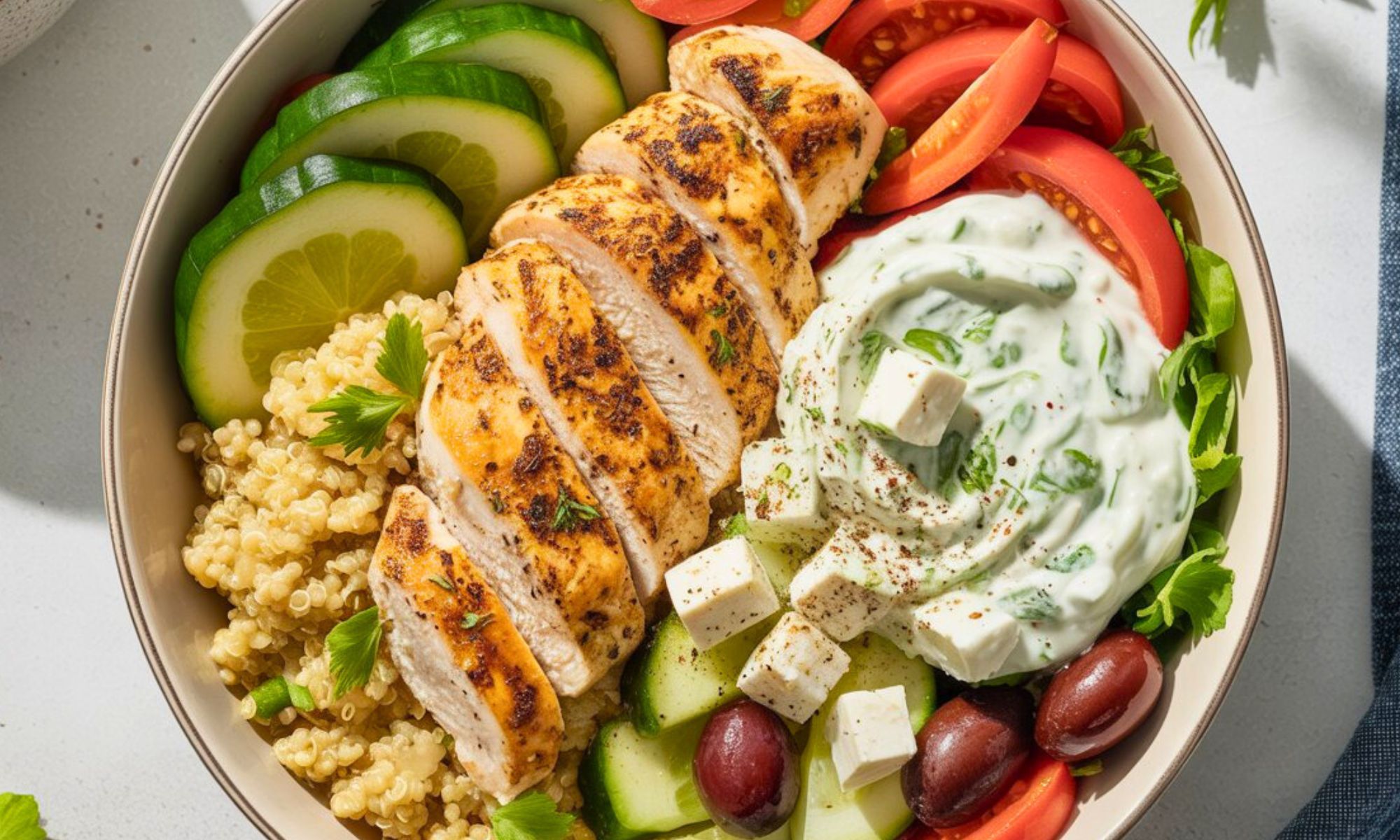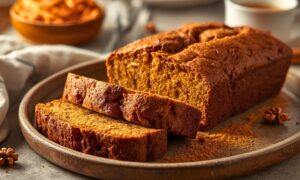This bowl doesn’t whisper “healthy” it sings with purpose.
Let’s break the mold. No soft focus stories about picnics or ancient grains rediscovered. This Greek Chicken Quinoa Bowl doesn’t rely on nostalgia. It delivers bold flavor, fast comfort, and a clean eating vibe without the usual clichés. It’s not just another salad; it’s a Greek Chicken Quinoa Bowl that resets your senses and rescues your weeknight dinner slump.
You know that moment, it’s late, your energy’s fried, and you’re circling the kitchen like a hawk over leftovers. You’re craving something fresh, something real, but your fridge looks more like a storage unit than a dinner plan. That’s exactly where I was. Just me, a half used lemon, leftover grilled chicken, and quinoa I made on autopilot three days ago.
But then it happened: I started building. Not measuring, just feeling. A sprinkle of feta. Crunchy cucumbers. Cherry tomatoes bursting like little sun drops. A quick olive oil and lemon dressing, laced with minced garlic and oregano. Suddenly, the kitchen smelled alive. The kind of alive that makes you stop mid bite and go, whoa.
This Greek Chicken Quinoa Bowl isn’t just food, it’s freedom. Light yet satisfying. Familiar but exciting. And shockingly simple to pull off. Stick around, I’ll walk you through it step by step. Trust me, once you taste this Greek Chicken Quinoa Bowl… it’ll earn a permanent spot in your weekly rotation
Why This Greek Chicken Quinoa Bowl Recipe Will Become Your New Obsession
Let’s be real here, most grain bowls are pretty forgettable. They promise the world but deliver something that tastes like cardboard with expensive toppings. This recipe? It’s different.
The secret weapon is building flavors in layers, just like they do in traditional Greek cooking. Every single component gets seasoned individually, then comes together to create something way more complex than the sum of its parts. It’s that technique that separates amateur cooking from the kind that makes people beg for your recipe.
And here’s what nobody tells you about Mediterranean cooking. It’s actually incredibly forgiving. Mess up the timing? No problem. Don’t have exactly the right herbs? We’ll make it work. This style of cooking embraces imperfection and turns it into deliciousness.
Essential Ingredients That Make the Magic Happen
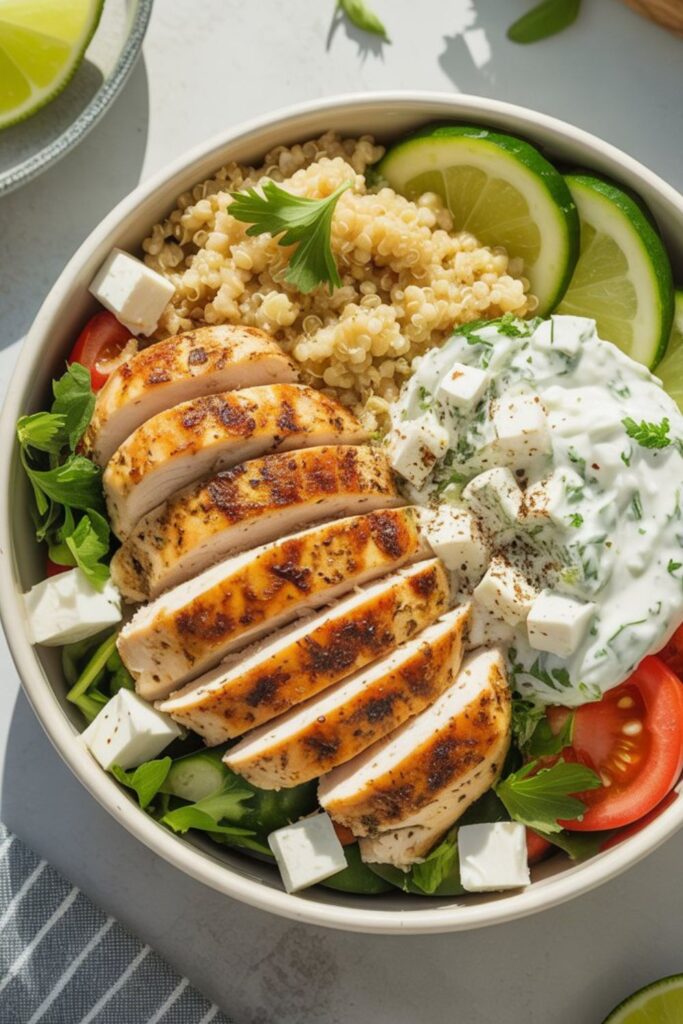
For the Perfect Quinoa Base:
- 1 cup quinoa (tri color if you’re feeling fancy)
- 2 cups chicken broth (or vegetable broth for vegetarians)
- 2 tablespoons olive oil
- 1/2 teaspoon salt
- Juice of 1/2 lemon
The Star of the Show, Mediterranean Chicken:
- 1.5 pounds boneless, skinless chicken thighs (trust me on this choice)
- 3 cloves garlic, minced fine
- 2 tablespoons fresh oregano (or 1 tablespoon dried)
- 1/4 cup olive oil
- Juice of 1 large lemon
- 1 teaspoon salt
- 1/2 teaspoon black pepper
- 1/2 teaspoon smoked paprika
Fresh & Vibrant Toppings:
- 1 English cucumber, diced
- 1 pint cherry tomatoes, halved
- 1/2 red onion, thinly sliced
- 1/2 cup Kalamata olives, pitted
- 1/2 cup crumbled feta cheese
- 1/4 cup fresh dill, chopped
- 1/4 cup fresh parsley, chopped
The Creamy Dream, Homemade Tzatziki:
- 1 cup Greek yogurt (full fat for richness)
- 1/2 English cucumber, grated and drained
- 2 cloves garlic, grated
- 2 tablespoons fresh dill
- 1 tablespoon lemon juice
- 1/2 teaspoon salt
Smart Swaps That Won’t Compromise Flavor
Can’t find chicken thighs for your Greek Chicken Quinoa Bowl? Boneless breasts work too. Just keep an eye on them so they don’t dry out. Thighs are more forgiving and stay juicy, even if Netflix distracts you.
No quinoa? Swap in brown rice or cauliflower rice. Brown rice needs more liquid; cauliflower needs less time. Still craving that Greek Chicken Quinoa Bowl vibe? These swaps keep the spirit alive.
Out of Greek yogurt? Strain full fat plain yogurt for an hour, It thickens into perfect tzatziki. Fresh herbs too pricey? Use dried, just half the amount.
No Kalamata olives nearby? Use any black olive. Even the canned ones will give you that essential briny kick.
Step by Step Magic: Building Your Greek Chicken Quinoa Bowl Like a Pro
Getting That Quinoa Perfect Every Single Time
Start with the quinoa because it takes the longest and you can multitask while it’s cooking. Here’s the technique that’ll change your quinoa game forever, toast it first.
Heat a dry pan over medium heat and toss in your quinoa for about 2-3 minutes until it smells nutty and starts making tiny popping sounds. This simple step adds incredible depth of flavor that most people never discover.
Now add your chicken broth (or vegetable broth if that’s your thing), bring it to a boil, then immediately reduce to low heat and cover. Set your timer for exactly 15 minutes and resist the urge to peek. Lifting that lid releases precious steam and messes with the cooking process.
After 15 minutes, remove from heat but keep the lid on for another 5 minutes. This lets the quinoa finish steaming and absorb any remaining liquid. Then fluff with a fork, drizzle with olive oil and lemon juice, and season with salt.
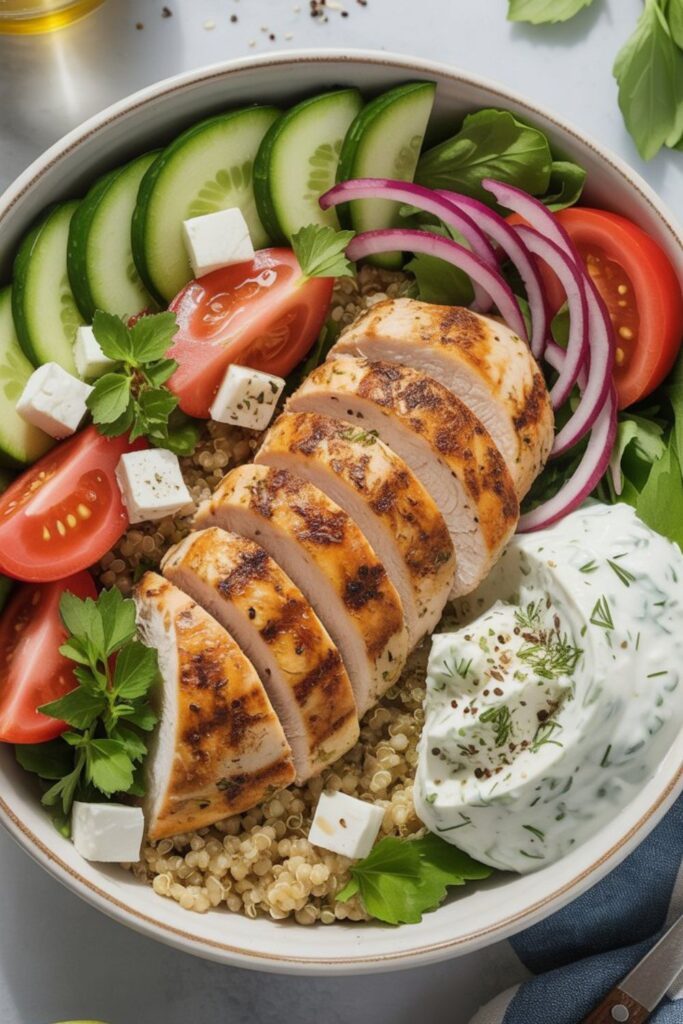
The Secret to Incredibly Juicy Chicken
While your quinoa is doing its thing, let’s talk chicken. Chicken thighs are your best friend here because they’re nearly impossible to overcook and they stay incredibly moist. Plus, they have more flavor than breasts.
Pat them completely dry, this is crucial for getting that beautiful golden sear. Season generously on both sides with salt, pepper, and that gorgeous mix of oregano, garlic, and smoked paprika.
Heat a large skillet over medium high heat with a tablespoon of olive oil. When it shimmers, lay those chicken thighs in carefully, they should sizzle immediately. Don’t move them for the first 5-6 minutes. I know it’s tempting, but that golden crust is forming and you don’t wanna mess with perfection.
Flip once and cook another 5-6 minutes. The internal temperature should hit 165°F, but honestly, thighs are so forgiving that as long as the juices run clear, you’re golden. Let them rest for 5 minutes before slicing, this keeps all those delicious juices from running out onto your cutting board.
Prepping the Fresh Elements
While your chicken rests, prep your fresh components. Dice that cucumber into small, uniform pieces, nobody wants giant chunks overwhelming each bite. Halve your cherry tomatoes and toss them with a pinch of salt. This draws out their natural sweetness and prevents them from making your bowl soggy.
For the red onion, slice it paper thin and give it a quick rinse under cold water. This takes away that harsh bite while keeping the crunch and subtle onion flavor we want.
The Tzatziki That’ll Ruin You for Store Bought Forever
Grate your cucumber on the large holes of a box grater, then squeeze out as much liquid as possible using a clean kitchen towel. This is absolutely critical, watery tzatziki is sad tzatziki.
Mix the drained cucumber with thick Greek yogurt, grated garlic, fresh dill, lemon juice, and salt. Taste and adjust, maybe you want more lemon brightness, or perhaps another pinch of salt to make all the flavors pop.
The longer tzatziki sits, the better it gets. The flavors meld together and become more complex. If you’re meal prepping, this stuff actually improves over 2-3 days in the fridge.
The Science Behind Those Incredible Mediterranean Flavors
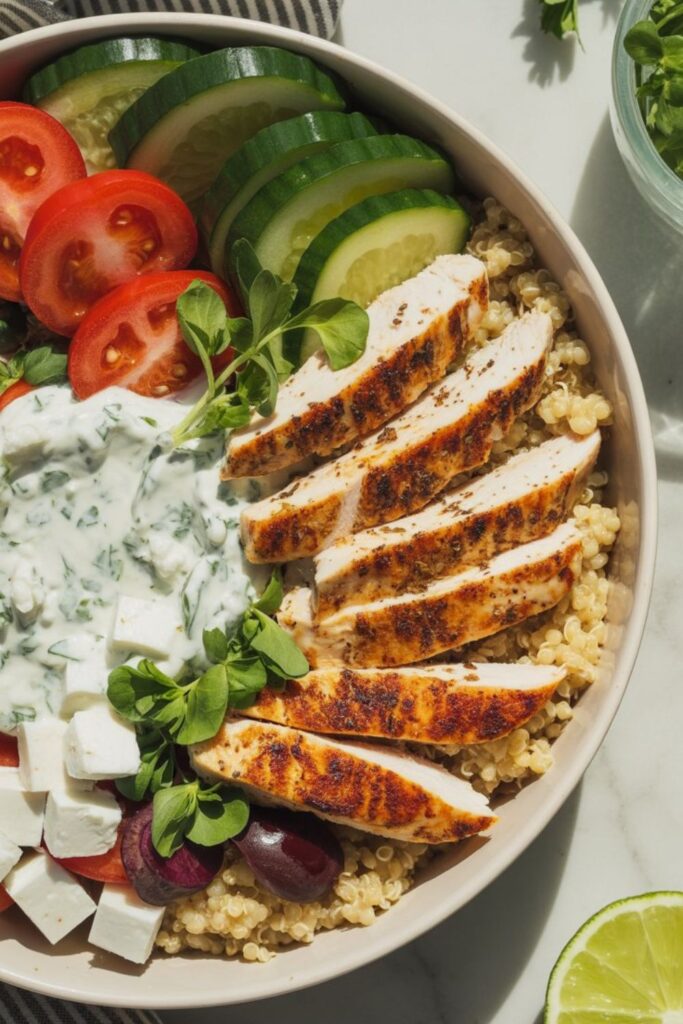
Ever wonder why Mediterranean food tastes so incredibly fresh and vibrant? It’s not magic, it’s smart technique and understanding how flavors work together.
The acid from lemon juice doesn’t just add brightness. It actually helps tenderize the chicken proteins while cooking. That’s why we marinate the chicken in lemon juice, and why we add more lemon to the quinoa. It’s layering acid throughout the dish for maximum impact.
Oregano and garlic are flavor powerhouses in Mediterranean cuisine because they contain compounds that enhance our perception of umami, that savory, satisfying taste that makes food incredibly craveable. When you combine them with the natural fats in olive oil, those flavors become even more pronounced and stick to your palate longer.
The olive oil isn’t just for cooking, it’s a flavor carrier. All those herbs and garlic? They’re fat soluble, which means they need fat to fully release their flavors. That’s why authentic Mediterranean cooking uses olive oil so generously.
Here’s something fascinating about quinoa that most people don’t know, it’s actually a seed, not a grain. That’s why it has such a unique texture and why toasting it creates those nutty, almost popcorn like flavors. The proteins in quinoa react to heat similarly to nuts, developing complex flavors through the Maillard reaction.
Why Your Tools Actually Matter
The right pan changes everything with this recipe. A heavy bottomed skillet retains heat better and gives you that gorgeous, even sear on the chicken. Thin pans create hot spots that burn some areas while leaving others pale and sad.
For quinoa, a heavy bottomed saucepan with a tight fitting lid is your best friend. It distributes heat evenly and traps steam effectively, giving you fluffy, perfectly cooked quinoa every single time.
A good box grater makes prep work so much faster and more consistent. Those tiny julienne strips from a dull grater just don’t have the same impact as properly grated cucumber and garlic.
Making It Beautiful and Instagram Worthy
Presentation isn’t just about pretty pictures, it actually affects how food tastes. Our brains process visual information first, and attractive food literally tastes better because of our expectations.
Start with your quinoa as the base, creating a small mound in your bowl. Slice that rested chicken on the bias, it looks more professional and creates better texture distribution. Fan it over one side of the quinoa, letting some of those gorgeous golden edges show.
Create color contrast by grouping your toppings rather than scattering them randomly. Put cherry tomatoes in one section, cucumber in another, olives clustered together. This creates visual interest and lets each component shine.
Crumble feta generously, don’t be shy. It adds white contrast and creamy richness that balances all those bright vegetables. Drizzle tzatziki artfully, not just a blob in the center. Think of it as the sauce that ties everything together visually and flavor wise.
Fresh herbs go on last, right before serving. They wilt quickly under hot ingredients, so save that vibrant green color by adding them at the very end.
Perfect Pairings That Complete the Experience
This bowl is incredibly satisfying on its own, but if you wanna create a full Mediterranean experience, consider these pairings. A crisp Sauvignon Blanc or dry Rosé complements those bright, herbaceous flavors beautifully. Not a wine person? Sparkling water with fresh lemon and mint feels appropriately refreshing.
For sides, warm pita bread or naan is perfect for scooping up extra tzatziki. Roasted red peppers add another layer of sweetness and smokiness. A simple Greek salad with just tomatoes, onion, and olive oil keeps the theme going without overwhelming the main event.
If you’re feeding a crowd, this recipe scales beautifully. Double everything except maybe go a little lighter on the garlic in the tzatziki, it gets stronger as quantities increase.
Why This Greek Chicken Quinoa Bowl Works Every Time
The Greek chicken quinoa bowl represents everything beautiful about Mediterranean cooking, fresh ingredients, simple techniques, and flavors that complement rather than compete with each other. It’s wholesome without being boring, satisfying without being heavy, and sophisticated without being complicated.
What makes this recipe truly special is how it transforms simple, everyday ingredients into something that feels both nourishing and indulgent. The protein from quinoa and chicken keeps you satisfied for hours, while all those fresh vegetables provide vitamins and that satisfying crunch we crave.
This is the kind of recipe you’ll find yourself making on repeat, for quick weeknight dinners, impressive weekend meals, or even meal prep when you want something healthy but exciting. Once you master the basic technique, you can riff on it endlessly. Try it with lamb instead of chicken, swap the feta for goat cheese, add roasted eggplant or zucchini when they’re in season.
The beauty of this Greek chicken quinoa bowl is that it gets better as you make it more often. You’ll develop your own preferences, maybe you like extra dill, or perhaps you prefer your chicken with a little heat from red pepper flakes. That’s the Mediterranean way, recipes are guidelines, not rigid rules.
Remember, great cooking isn’t about perfection, it’s about creating something delicious that brings joy to your table. This recipe will do exactly that, whether you’re cooking for one or feeding a houseful of people who’ll be begging for seconds.
Frequently Asked Questions about Step by Step Magic: Building Your Greek Chicken Quinoa Bowl Like a Pro
Can I make this Greek chicken quinoa bowl ahead of time for meal prep?
Absolutely! This recipe is actually perfect for meal prep. Cook your quinoa and chicken, then store them separately in the fridge for up to 4 days. Prep all your fresh vegetables and store them in separate containers too. The tzatziki gets better after sitting for a day or two, so make that ahead as well. When you’re ready to eat, just assemble your bowl and enjoy. The only thing I’d recommend is adding fresh herbs right before eating so they stay bright and vibrant.
What’s the best way to reheat the chicken without drying it out?
Here’s the trick, add a tablespoon of chicken broth or water to your container before reheating. Cover it and microwave in 30-second intervals, checking between each one. The steam from the liquid keeps the chicken moist. Alternatively, reheat it gently in a covered skillet over low heat with a splash of broth. Never reheat on high heat, that’s what turns juicy chicken into shoe leather.
Can I substitute the quinoa with something else if I don’t like the texture?
Of course! Brown rice, wild rice, or even cauliflower rice work beautifully. For regular rice, use the same cooking method but increase the liquid to 2.5 cups and cook for about 18-20 minutes. Cauliflower rice cooks much faster, just sauté it with a little olive oil for 3-4 minutes until tender. The flavors work with any base you choose, so pick what makes you happy.
How do I know when my chicken thighs are perfectly cooked?
Chicken thighs are done when they reach an internal temperature of 165°F, but honestly, thighs are so forgiving that visual cues work great too. The juices should run clear when you pierce the thickest part, and the meat should feel firm but still give slightly when pressed. If you’re nervous, invest in an instant read thermometer, it takes all the guesswork out of cooking meat.
My tzatziki turned out watery. What went wrong?
This happens when you skip the cucumber draining step or don’t squeeze out enough liquid. Next time, grate your cucumber, toss it with a pinch of salt, and let it sit in a strainer for 15 minutes. Then wrap it in a clean kitchen towel and squeeze hard, you’ll be amazed how much water comes out. Also make sure you’re using thick Greek yogurt, not regular yogurt. If it’s already watery, you can strain it through cheesecloth for an hour to thicken it up

Swiftly Captions by Tina Smith — Quick, flavorful food recipes made simple, bringing fresh inspiration to your kitchen every day
